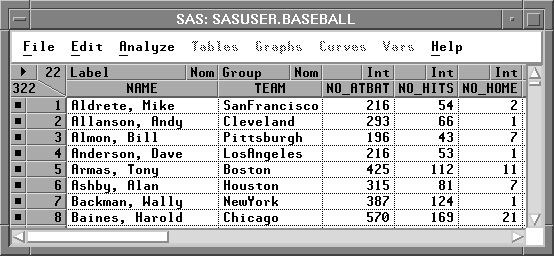Chapter Contents
Previous
Next
|
Chapter Contents |
Previous |
Next |
| Data Windows |
The column headings in a data window give information on each variable, including the name, label, default roles, and measurement level. The number of variables appears in the upper left corner of the data window.

A variable's default role assigns the role a variable plays by default in graphs and analyses. Click in the upper left portion of the variable header to display a pop-up menu of variable roles.
![[menu]](images/dateq2.gif)
Figure 31.5: Variable Roles Pop-up Menu
You can assign four default roles:
![[menu]](images/dateq3.gif)
Up to 250 variable measurement levels can be stored with a data set.
Default roles and measurement levels are displayed in the column headings above the variable names. The default role appears at the upper left of the column heading and the measurement level appears at the upper right. If a variable has more than one default role, then only the first character of each role appears.
In Figure 31.4, NAME has a label default role, and TEAM has a group default role. NAME and TEAM both have a nominal measurement level, while the remaining variables have an interval measurement level.
Note | Up to 250 measurement levels can be stored in the SAS data set. You can use the data pop-up menu to create new variables or to change the default role or measurement level of existing variables. |
For more information, see the section "Data Menu" later in this chapter.
You can use the Edit:Variables menu to create new variables that are transformations of existing variables. See Chapter 20, "Transforming Variables," for more information.
|
Chapter Contents |
Previous |
Next |
Top |
Copyright © 1999 by SAS Institute Inc., Cary, NC, USA. All rights reserved.